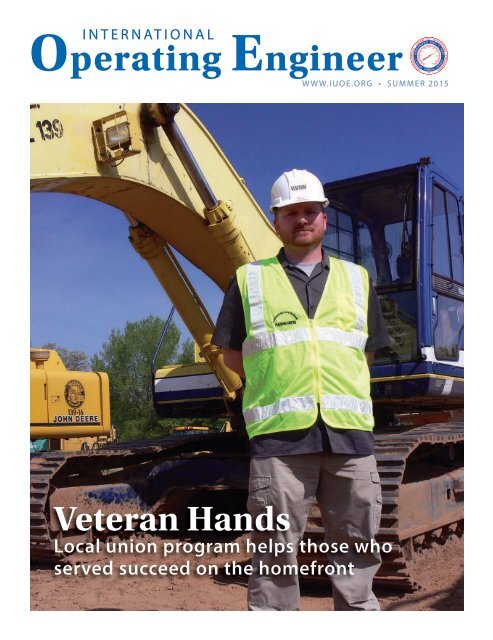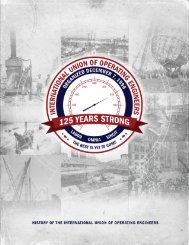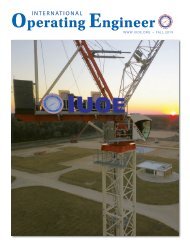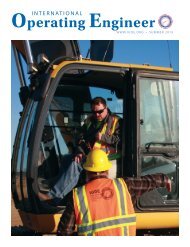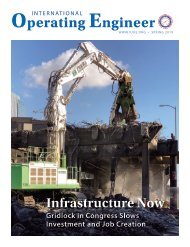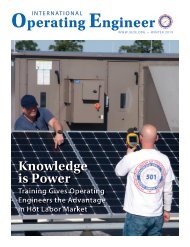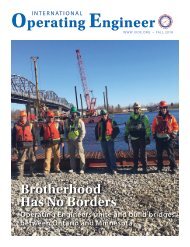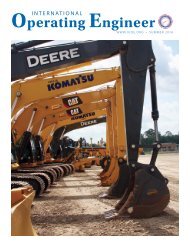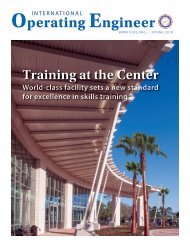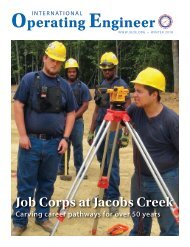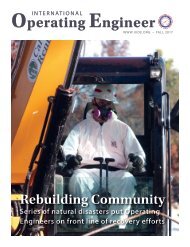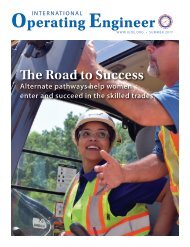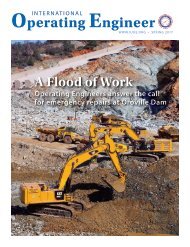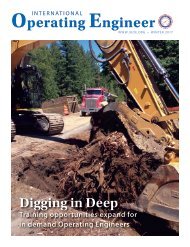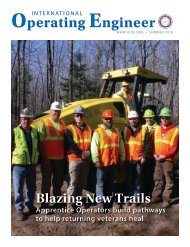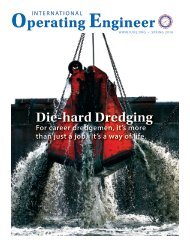International Operating Engineer - Summer 2015
The quarterly magazine of the International Union of Operating Engineers.
The quarterly magazine of the International Union of Operating Engineers.
- No tags were found...
Create successful ePaper yourself
Turn your PDF publications into a flip-book with our unique Google optimized e-Paper software.
i n t e r n at i o n a l<br />
<strong>Operating</strong> <strong>Engineer</strong><br />
WWW.IUOE.ORG • SUMMER <strong>2015</strong><br />
Veteran Hands<br />
Local union program helps those who<br />
served succeed on the homefront
i n t e r n at i o n a l<br />
<strong>Operating</strong> <strong>Engineer</strong><br />
<strong>Summer</strong> <strong>2015</strong> • Volume 158, No. 3<br />
Brian E. Hickey, Editor<br />
Jay C. Lederer, Managing Editor<br />
16 Boom Time<br />
Great training opens up great opportunities<br />
18 Speaking Out for Worker Health<br />
From operating cranes to saving lives<br />
16 ‘Combat 2 Construction’<br />
Guiding veterans into the employment ranks<br />
20 Union Plus Scholarship Winners<br />
IUOE has ten worthy recipients this year<br />
Departments<br />
05 From the General President<br />
06 Education & Training<br />
08 Safety & Health<br />
10 Politics & Legislation<br />
18 Canadian News<br />
22 GEB Minutes<br />
28 In Memorium<br />
[cover] Dana Elmhorst is participating in Local 139’s ‘Combat<br />
2 Construction’ program in part because he built roads<br />
while serving in the Army.<br />
[photo] Dave Backmann/IUOE Local 139<br />
2<br />
INTERNATIONAL OPERATING ENGINEER<br />
SUMMER <strong>2015</strong> 3
<strong>International</strong> <strong>Operating</strong> <strong>Engineer</strong><br />
(ISSN 0020-8159) is published by the:<br />
<strong>International</strong> Union of<br />
<strong>Operating</strong> <strong>Engineer</strong>s, AFL-CIO<br />
1125 17 th Street, NW<br />
Washington, DC 20036<br />
Subscription Terms - $5 per year<br />
Change of Address - Requests must<br />
be submitted in writing to the IUOE<br />
Membership Department (address<br />
above). Include your new address,<br />
registration and local union number.<br />
POSTMASTERS – ATTENTION:<br />
Change of address on Form 3579<br />
should be sent to:<br />
<strong>International</strong> <strong>Operating</strong> <strong>Engineer</strong><br />
Mailing List Dept.<br />
1125 17th St., NW, 3rd Floor<br />
Washington, DC 20036<br />
Publications Mail Agreement No.<br />
40843045<br />
Canada Post:<br />
Return undeliverables to<br />
P.O. Box 2601, 6915 Dixie Rd,<br />
Mississauga, ON L4T 0A9<br />
Printed in the U.S.A.<br />
<strong>International</strong> Union of <strong>Operating</strong> <strong>Engineer</strong>s<br />
AFL-CIO<br />
general officers<br />
James T. Callahan, General President<br />
Brian E. Hickey, General Secretary-Treasurer<br />
William C. Waggoner, First Vice President<br />
Jerry Kalmar, Second Vice President<br />
Russell E. Burns, Third Vice President<br />
James M. Sweeney, Fourth Vice President<br />
Robert T. Heenan, Fifth Vice President<br />
Daniel J. McGraw, Sixth Vice President<br />
Daren Konopaski, Seventh Vice President<br />
Michael Gallagher, Eighth Vice President<br />
Greg Lalevee, Ninth Vice President<br />
Terrance E. McGowan, Tenth Vice President<br />
Louis G. Rasetta, Eleventh Vice President<br />
Mark Maierle, Twelfth Vice President<br />
Randy Griffin, Thirteenth Vice President<br />
Douglas W. Stockwell, Fourteenth Vice President<br />
Got Big<br />
News<br />
?<br />
from Your<br />
Local<br />
We want to<br />
hear about it.<br />
trustees<br />
Kuba J. Brown, Chairman<br />
Bruce Moffatt, Trustee<br />
James T. Kunz, Jr., Trustee<br />
Joseph F. Shanahan, Trustee<br />
Edward J. Curly, Trustee<br />
<strong>International</strong> <strong>Operating</strong> <strong>Engineer</strong><br />
appreciates the stories and<br />
photos we receive from<br />
local affiliates throughout<br />
North America. Send us your<br />
submissions or ideas for stories<br />
you would like us to consider.<br />
Send your submissions, plus<br />
photos (digital images are<br />
preferred), to Jay Lederer<br />
at jlederer@iuoe.org, or mail<br />
1125 Seventeenth Street, N.W.,<br />
Washington, D.C., 20036<br />
From the General President<br />
That <strong>Summer</strong>time Swing<br />
As work hours intensify let’s keep it safe<br />
I HOPE YOU all are enjoying the<br />
summer weather at long last. We<br />
know from reports at the most recent<br />
General Executive Board meeting<br />
that our hoisting and portable locals<br />
are experiencing a great summer<br />
construction season, manning many<br />
projects with nearly full employment.<br />
The red hot pipeline industry<br />
has cooled off some with a reported<br />
reduction in overall hours due to the<br />
decline in oil prices and demand for<br />
production. In terms of job creation,<br />
this sector has led the way out of the<br />
recession and, despite the recent<br />
slowdown, remains a strong industry<br />
for <strong>Operating</strong> <strong>Engineer</strong>s.<br />
Our Stationary Department<br />
continues to engage in the regulatory<br />
and rule making process, attending<br />
meetings and being a strong voice<br />
for our members. This work is not<br />
glamorous, but it is vitally important<br />
as we address serious issues pertaining<br />
to safety and licensing matters where<br />
Building Operators are affected.<br />
The <strong>International</strong>’s Health Care<br />
Initiatives Department, headed by<br />
David Treanor, has been diligently<br />
monitoring the costs and regulatory<br />
affects of the ever changing health<br />
care industry and the burdens put<br />
upon our Health and Welfare Funds<br />
to supply quality care to our members.<br />
I commend him and all the Fund<br />
Administrators and Trustees for their<br />
efforts.<br />
I am pleased to report that progress<br />
continues on the planning and<br />
development of the <strong>International</strong><br />
Training Center. A committee of<br />
local Training Directors and our<br />
<strong>International</strong> staff has been working<br />
closely with architects, geotechnical<br />
experts and others to develop a state<br />
of the art training facility. Our union’s<br />
commitment and investment in high<br />
quality training will be greatly enhanced<br />
and provide even more opportunity to<br />
our membership to attain the highest<br />
qualifications in their chosen craft. I<br />
look forward to sharing more details as<br />
the project moves forward.<br />
It’s hard to believe, but the<br />
presidential election of 2016 is<br />
already underway. The battle lines<br />
have been drawn and it’s clear that<br />
the frontrunners in the crowded<br />
conservative field are fully prepared<br />
to do the bidding of corporate power<br />
brokers who seek to weaken the rights<br />
of working men and women.<br />
A full eighteen months away from<br />
the election, the candidates and their<br />
campaign committees are awash in<br />
record amounts of cash. They are<br />
being staked by the wealthy elites who<br />
wish to widen the divide by rolling<br />
back basic workers’ rights to organize,<br />
bargain collectively and have a secure<br />
retirement. And these candidates are<br />
unashamed as they attempt to cast<br />
American workers and their unions as<br />
the cause for all of society’s ills.<br />
I implore each of you to educate<br />
yourselves and cut through the hype.<br />
Your home local has solid background<br />
information on the perils we face in<br />
maintaining good paying jobs and<br />
health and retirement benefits. Utilize<br />
these resources and make an informed<br />
choice.<br />
We all understand the struggles<br />
to provide for our families. We must<br />
stay focused on that which affects our<br />
livelihoods most and not get distracted<br />
by over-hyped social issues that<br />
disguise politicians’ true intentions<br />
towards our work. We have seen too<br />
many examples of that this year in<br />
state legislatures, where politicians<br />
got elected running on certain issues,<br />
[James T. Callahan]<br />
but then went to work eliminating or<br />
weakening our rights and prevailing<br />
wages behind the scenes. Your local<br />
union has an eye on these attempts<br />
and certainly needs your voice to beat<br />
back these attacks from your local<br />
legislators.<br />
Unfortunately, our brothers and<br />
sisters in Canada are not immune to<br />
similar political challenges. Since<br />
the Harper Conservative government<br />
came to power, they have worked to<br />
undercut the labor movement there.<br />
The last minute passage of Bill C-377 in<br />
July underscores their determination<br />
to weaken unions and target workers.<br />
Fortunately, <strong>Operating</strong> <strong>Engineer</strong>s<br />
throughout Canada have a chance<br />
to change their government on<br />
October 19. I urge every member to<br />
exercise their vote and support those<br />
who believe in a strong and vibrant<br />
Canadian labor movement. And when<br />
you do, take a friend or co-worker or<br />
family member with you. Let’s all keep<br />
fighting to make both countries union<br />
strong.<br />
Brothers and sisters, as your work<br />
hours increase throughout these<br />
summer months, let’s work safely and<br />
always keep a watchful eye on those<br />
around you. It is imperative that you<br />
all go home to your families at the end<br />
of the day.<br />
4<br />
INTERNATIONAL OPERATING ENGINEER<br />
SUMMER <strong>2015</strong> 5
Education & Training<br />
Boom Time<br />
Great training opens up great opportunities<br />
FIFTY MILES NORTHEAST of<br />
Edmonton, Alberta, a team of side<br />
boom operators moves hundreds of<br />
feet of pipe. Working in tandem, they<br />
keep a keen eye on each other and their<br />
surroundings, skillfully maneuvering<br />
their machines below an overhead<br />
power line to lay the pipe in place.<br />
Sounds like a typical day working<br />
pipeline. But this is definitely different.<br />
You wouldn’t know it watching them<br />
work, but three weeks ago, none of the<br />
people in the seats had operated a side<br />
boom before.<br />
These operators are the latest<br />
graduates of the Side Boom Year 1<br />
course presented by IUOE Local 955<br />
Alberta’s Training Trust Fund.<br />
The course runs in springtime each<br />
year, when the thawing ground restricts<br />
movement of heavy equipment.<br />
During this brief pipeline breakup<br />
window, Local 955’s Training Center is<br />
dedicated exclusively to the side boom<br />
course for three weeks. Students spend<br />
10-hour days at the Center, which is<br />
comprised of a 3,000-square-foot,<br />
modern classroom facility on 160 acres<br />
of land. One or two hours per day are<br />
spent in the classroom, and the rest of<br />
the time is spent working on and in the<br />
machine.<br />
The course covers subject matter<br />
and processes including: Occupational<br />
Health and Safety regulations,<br />
characteristics of the machine,<br />
machine systems, basic operations,<br />
multiple control manipulation,<br />
construction rigging, hoisting signals,<br />
and performing lifts.<br />
The quality of union equipment<br />
training is unmatched in the industry.<br />
The key to our students’ success is<br />
the low student-to-instructor—and<br />
student-to-machine—ratio. For side<br />
boom training, that ratio is kept at two<br />
to one. Our last intake put 18 students<br />
through the course.<br />
As Training Trust Fund<br />
Administrator Darlene Pysyk<br />
describes, “The fact that we can train 18<br />
to 20 guys in one training session, that<br />
isn’t something that’s available across<br />
Canada. We free up our schedule and<br />
that’s what we do for that period of<br />
time—we do side boom training. Other<br />
training providers don’t do things that<br />
exclusively and to that extent.”<br />
The large capacity of the course is<br />
made possible through partnerships<br />
with employers, who loan the side<br />
booms to Local 955 for the course<br />
during the spring breakup season. “It’s<br />
in their best interest to provide us with<br />
the equipment,” Pysyk says, “because<br />
in turn we provide them with trained<br />
workers.”<br />
Students learn on the same<br />
equipment used in the field, both<br />
newer hydraulic-draw machines and<br />
live-draw models that are still prevalent<br />
in the industry. “We have 160 acres<br />
so it’s not hard for us to manage nine<br />
side booms,” notes Pysyk. Students get<br />
ample opportunity to practice skills,<br />
and complete the course ready to<br />
perform on the job site.<br />
Alternatives for side boom<br />
training are rare and nowhere near<br />
as comprehensive. Focused on profit,<br />
these facilities push as many students<br />
through a course as possible, sacrificing<br />
individual attention and seat time per<br />
student.<br />
Local 955’s training—offered free<br />
of charge to referred and approved<br />
members—puts the focus on the<br />
student. As Pysyk says, “Members get<br />
two-to-one training. They don’t have<br />
eight guys that they have to share a side<br />
boom with, they’ve got one.”<br />
With only two students sharing<br />
each machine, it works out to each<br />
person getting about 60 hours of actual<br />
seat time in the side boom throughout<br />
the course.<br />
Students gain invaluable experience<br />
from all that seat time. They learn to<br />
work in tandem, to communicate, to<br />
watch for what other operators are<br />
doing. They are taught to be aware<br />
of their surroundings and practice<br />
constant observation. Student Aaron<br />
Meunier says, “The whole course was<br />
an eye-opener. Learning wrong from<br />
right when running live [draw side<br />
boom] was a big part of the course<br />
and you learn a lot from the hands-on<br />
training.”<br />
Another successful student, Brett<br />
Chern, says the biggest thing he took<br />
away from the course was confidence.<br />
“When you’re running a side boom<br />
there’s always guys and crews around<br />
you and you have to be confident<br />
operating the machine, because that’s<br />
somebody’s life you’re responsible for.”<br />
In addition to experience and<br />
confidence, students walk away from<br />
the course with increased earning<br />
potential. All students typically have<br />
some experience in the pipeline<br />
industry prior to the course, but this<br />
training gives them the opportunity to<br />
move from laborer positions to actual<br />
operating and gain the pay increase<br />
that goes along with that.<br />
Local 955 views all of our<br />
equipment, safety, and skills training<br />
as an investment in our membership.<br />
A highly trained, safety-conscious<br />
work force is the promise we make to<br />
industry. The focus and dedication of<br />
the staff, employers, and students that<br />
participate in our side boom course is<br />
the living fulfillment of that promise.<br />
[left] A Local 955 student completes a field<br />
exercise.<br />
[above] Local 955’s side boom class of<br />
<strong>2015</strong>.<br />
[article & photos] Austin Havens, IUOE<br />
Local 955 Training Trust<br />
NTF Equipment<br />
Program Keeps<br />
Rolling<br />
IN THE INTEREST of keeping<br />
our members trained on the latest<br />
construction equipment, the IUOE<br />
National Training Fund has continued<br />
the leasing program with John Deere.<br />
There are six sets of construction<br />
equipment that are moved following a<br />
schedule to different training centers<br />
across the United States and Canada.<br />
The sets of equipment consist of a<br />
75G Excavator and a 344K Loader with<br />
a fork attachment.<br />
Pictures shown are courtesy of<br />
Local 926 in Georgia where one of the<br />
first sets were delivered.<br />
6<br />
INTERNATIONAL OPERATING ENGINEER<br />
SUMMER <strong>2015</strong> 7
Safety & Health<br />
Jobsite Pioneer Speaks Out for Worker Health<br />
Local 470 member tells how she went from operating cranes to saving lives<br />
AT ONE TIME she was in beauty school. A handful of years<br />
later, she could operate every single crane at the Department<br />
Of Energy’s Savannah River Site. And then, years after that,<br />
she started helping her former coworkers receive medical<br />
screenings for health problems they may have developed<br />
from hazards they were exposed to on the site.<br />
Talking to Glenda Jernigan is like hearing firsthand the<br />
history of labor in the late 20th century, both its successes and<br />
shortcomings. When she started at the Savannah River Site<br />
in 1983, her employers, MK Ferguson and later Bechtel, had<br />
never employed a woman as a crane operator. But operating<br />
cranes is exactly what Glenda had been trained to do from<br />
previous work with the IUOE. After passing a rigorous safety<br />
test, she became the first female crane operator employed by<br />
either of those contractors on the site.<br />
At a site like Savannah River, being able to operate a crane<br />
meant that Glenda was needed all over. She was an A-Class<br />
crane operator and could operate any crane on-site, including<br />
the Manitowoc-4100 which had a 250 foot boom and a 30 foot<br />
jib. She performed dual-lifts with other operators, and even<br />
used cameras to remotely operate cranes in waste transfer<br />
stations that were so radioactive that nobody was allowed<br />
inside. “I did some of everything,” she remembers. “I worked<br />
with every craft out there- the painters, the electricians, the<br />
boilermakers, the pipefitters, the ironworkers, the laborers.<br />
Everybody.”<br />
“And I had to dress out, go into radioactive areas. 221-H<br />
was the worst,” she pauses. “A lot of contamination in that<br />
area.”<br />
Of course, Glenda wasn’t the only worker who was exposed<br />
to radiation and other hazards while working construction<br />
at a DOE site. Thousands of workers, at Savannah River<br />
and at DOE sites across the country, have come face to face<br />
with materials and radiation that can have very serious<br />
health effects several years after exposure. “Trucks carrying<br />
radioactive waste would come out of the H-area Tank Farm,<br />
they’d leak and then safety crews would have to tear out<br />
the pavement. They’d tear up everything. And they’d even<br />
have to take the tires and wheels and different things off of<br />
peoples’ cars if they drove on contaminated ground,” she<br />
says. “I mean, you can see it going on around you and you<br />
know it’s not good.”<br />
Now, we know all too well what kinds of exposures Glenda<br />
and her coworkers could have encountered. Benzene.<br />
Radiation. Asbestos. Lead. The list goes on.<br />
Even today, Glenda is still piecing together how her body<br />
may be reacting to all the hazards she worked around. “It’s<br />
hard to put your finger on it to say this caused this, this<br />
caused that,” she sighs. “But I’m sure that some of the things<br />
I was exposed to have affected my lungs. My doctor told me I<br />
have asthma, and I never had asthma growing up as a child.<br />
This has only been in the last few years… and I have to take<br />
medication for it every day.”<br />
All this led Glenda to the Building Trades National<br />
Medical Screening Program (BTMed). BTMed, coordinated<br />
through CPWR – The Center for Construction Research and<br />
Training, offers free work history interviews and medical<br />
screenings to former construction workers at DOE sites. For<br />
several years, Glenda and her husband Charles (IBEW 1579)<br />
worked together as a team out of BTMed’s Savannah River<br />
outreach office, helping to inform workers about the benefits<br />
of BTMed. If BTMed can catch a serious illness early enough,<br />
it may prevent an early death.<br />
“We both talked about it, and we decided that it was a very<br />
good program, and we liked the idea of helping the workers<br />
at SRS and the other DOE sites because we knew what they<br />
were going through,” Glenda recalls. “Most people thought<br />
that there’s nothing out there to hurt workers, these workers<br />
are getting sick and things are happening to them for other<br />
reasons, it’s not what they’re getting exposed to on the job.<br />
And Charles and I both knew that that wasn’t true.”<br />
In ten years working for BTMed Glenda has interviewed<br />
hundreds of former SRS workers and heard their stories.<br />
“This one guy that I interviewed in our office…told me he<br />
actually put on diving gear and went down in a nuclear<br />
reactor pool because they had a leak in there, a crack in the<br />
reactor. And they were going to try to patch the crack. Now<br />
can you imagine that? And somebody letting him go do that?<br />
He ended up with thyroid cancer, I don’t know if he’s still<br />
alive or not.”<br />
Glenda has since retired from her position with BTMed,<br />
but her husband still works there, signing up as many former<br />
DOE construction workers as he can to get their health<br />
checked out. Workers are eligible for free checkups every<br />
three years, in order to catch an illness that might not show<br />
symptoms on the first exam. If you or someone you know<br />
worked construction at Savannah River or another DOE<br />
site across the country, visit www.btmed.org or call 1-800-<br />
866-9663 for more information. “[Those are] very dangerous<br />
place[s] to work,” Glenda warns. “And if you don’t know what<br />
you’re getting yourself into, you better be careful.”<br />
[left] Glenda Jernigan, one of the first female crane operators at<br />
the Savannah River DOE Site, sitting at the controls of her crane.<br />
[below] Map detailing DOE sites where former workers are eligible<br />
for free medical screenings through the BTMed program.<br />
[article] Building Trades National Medical Screening Program<br />
8<br />
INTERNATIONAL OPERATING ENGINEER<br />
SUMMER <strong>2015</strong> 9
Politics & Legislation<br />
Legislation Would Eliminate Workers’ Rights on Tribal Lands<br />
LEGISLATION IS MOVING in<br />
Congress that would strip hundreds of<br />
thousands of American workers of their<br />
fundamental workplace rights in tribalowned<br />
businesses on Native American<br />
lands. The legislation is focused on the<br />
tribal gaming industry – a $28 billion<br />
enterprise in the United States – but<br />
would extend to every other operation<br />
of the tribe, too. <strong>Operating</strong> <strong>Engineer</strong>s<br />
are employed at many of these facilities<br />
at locations all over the United States,<br />
from Connecticut to California.<br />
The bill changes current law<br />
by exempting the National Labor<br />
Relations Act (NLRA) from tribal<br />
enterprises on tribal lands. Tribal<br />
enterprises include mining operations,<br />
ski resorts, commercial farms, golf<br />
courses, sawmills, construction firms,<br />
restaurant and entertainment facilities<br />
and other businesses. There is currently<br />
no definition of “tribal enterprise”<br />
anywhere else in law.<br />
In a letter to Congress, IUOE Local<br />
953 Business Agent and enrolled<br />
member of the Navajo Nation Clayton<br />
Benally stated that, “Employees of<br />
tribal operations should not have<br />
their right to form unions and bargain<br />
collectively taken away.”<br />
“I find it unacceptable,” Benally<br />
continued, “that our elected leaders<br />
in Washington would attempt to take<br />
away our rights to bargain collectively<br />
for the betterment of ourselves and our<br />
families as Americans, even our rights<br />
as Native Americans on our own Tribal<br />
lands.”<br />
This bill is a poorly disguised<br />
attack on workers’ rights. Passage<br />
of this bill would strip employees of<br />
tribal enterprises of their right to form<br />
unions and bargain collectively. Close<br />
to 700,000 people work at Indian<br />
gaming facilities across the country.<br />
About 600,000 of them are not Native<br />
American.<br />
The Tribes say that they want to<br />
be treated like state governments and<br />
[photo] Slot Technicians and other <strong>Operating</strong> <strong>Engineer</strong> jobs at tribal gaming facilities<br />
nationwide are under threat of losing their federal labor protections.<br />
that it is a matter of sovereignty. But<br />
states don’t operate a $28 billion dollar<br />
gaming industry with 700,000 workers.<br />
At a June congressional hearing,<br />
Richard Guest, the staff attorney for the<br />
Native American Rights Fund, publicly<br />
stated that the reason his organization<br />
supports this bill is because it will keep<br />
unions off of reservations. Another<br />
tribal witness said that they want to<br />
deny workers the right to strike.<br />
Make no mistake, this legislation is<br />
a business proposition for the Tribes.<br />
They are wielding their political<br />
power in an attempt to squash the<br />
fundamental rights of their employees.<br />
According to the National Indian<br />
Gaming Commission, Indian gaming<br />
generated $28 billion in revenue in fiscal<br />
year 2013 and operated 449 gaming<br />
facilities. Indian gaming enterprises<br />
also collectively paid 250 lobbyists over<br />
$24 million to lobby Congress in 2014<br />
and they contributed over $14 million<br />
in the 2014 election cycle to federal<br />
candidates and committees, according<br />
to the Center for Responsive Politics.<br />
Native American Tribes should not<br />
get to pick and choose what federal laws<br />
and regulations they will obey when<br />
they engage in commercial activity with<br />
people and business organizations<br />
from outside their reservations. This is<br />
not an issue of tribal sovereignty; it’s an<br />
issue of workers’ rights.<br />
The legislation has already passed<br />
through the Senate Indian Affairs<br />
Committee, with some Democratic<br />
support. It is currently being considered<br />
in the House committee.<br />
Saving the Highway Fund and Jobs Comes Down to the Wire<br />
THE CURRENT HIGHWAY BILL was<br />
due to expire at the end of July. As<br />
this magazine went to press, separate<br />
and competing bills in the House<br />
and Senate were being considered to<br />
extend the program. The question is<br />
over how long to extend it.<br />
Over the past several years, Congress<br />
has been passing short-term extension<br />
after short-term extension. Their<br />
failure to pass a long-term bill has cost<br />
thousands of <strong>Operating</strong> <strong>Engineer</strong>s jobs.<br />
The IUOE supports a long-term, fully<br />
funded program. Congress must come<br />
up with about $15 billion every year for<br />
the program. Unfortunately, neither<br />
Democrats nor Republicans have had<br />
the will to fund this critical program.<br />
Without a fully funded, long-term<br />
highway bill, the United States will<br />
never be able to repair and rebuild our<br />
crumbling infrastructure.<br />
According to the 2013 report by the<br />
American Society of Civil <strong>Engineer</strong>s<br />
(ASCE):<br />
• 32% of America’s major roads are<br />
in poor or mediocre condition<br />
• 42% of America’s major urban<br />
highways are congested<br />
• 1 in 9 of the nation’s bridges are<br />
rated as structurally deficient<br />
• 45% of Americans lack access to<br />
public transit<br />
• The U.S is ranked 16th in the<br />
world in terms of our overall<br />
infrastructure quality<br />
The <strong>Operating</strong> <strong>Engineer</strong>s are not alone<br />
in advocating for a fully funded, longterm<br />
highway bill. Many organizations<br />
and industry groups that span the<br />
political spectrum have been pleading<br />
with Congress for years to work<br />
together and get this done.<br />
Stay up-to-date on how Congress<br />
decides to address this critical issue by<br />
visiting: www.iuoe.org<br />
EnginEErs Action rEsponsE nEtwork<br />
Because elections matter<br />
Make your voice heard • Register for EARN today<br />
www.iuoe.org<br />
10<br />
INTERNATIONAL OPERATING ENGINEER<br />
SUMMER <strong>2015</strong> 11
Local Spotlight<br />
Longevity Has Its Place—In the <strong>Operating</strong> <strong>Engineer</strong>s<br />
“WE ARE THE HEART and soul of these buildings,” says<br />
Nicholas D’Elia. “These high-rise buildings cannot operate<br />
without us.”<br />
D’Elia, 55, chief engineer in the Colgate-Palmolive<br />
Building at 300 Park Ave., has worked there for 35 years. On<br />
June 10, he was one more than 300 members of Local 94 of<br />
the <strong>International</strong> Union of <strong>Operating</strong> <strong>Engineer</strong>s honored<br />
for having more than 25 years of service. Modesto Diaz<br />
topped the list, with 50 years; Philip Knollmueller and<br />
Raymond Lopez had 45 years; and a dozen more had 40. The<br />
6,000-member union represents the workers who keep the<br />
city’s office buildings going: running the heat, ventilation,<br />
and air-conditioning systems; being in charge of fire safety;<br />
maintaining and repairing motors and pumps; and doing<br />
plumbing, rigging, and anything else needed.<br />
The union also held a moment of silence to remember<br />
James Coffey, an 85-year-old retiree who’d suffered a fatal<br />
heart attack the day before after teaching a class. “He died<br />
the way he wanted, being a member of Local 94 and training<br />
members to the bitter end,” Local 94 President Kuba Brown<br />
said.<br />
Originally, D’Elia wanted to be a firefighter, he says, but<br />
he needed a job, and a friend of his father’s who worked at<br />
300 Park Ave. told him about an opening there. He had taken<br />
a trade-school course in refrigeration and HVAC, and gotten<br />
the refrigeration license needed to qualify—“to show you can<br />
operate equipment without blowing things up,” he jokes.”<br />
12<br />
“I was taught early on to learn a trade,” he says.<br />
Al Constantine, a 54-year-old Syrian immigrant honored<br />
for 25 years in the union, also came to the job via trade<br />
school. Augie Repetto, 65, is about to retire after 40 years. A<br />
transit police officer laid off in the city’s 1975 fiscal crisis, he<br />
heard about an opening through his father, who was also in<br />
the union.<br />
“This is a family atmosphere,” says Kuba Brown. “We’re<br />
predominantly a father-son union, but we’re open to all<br />
creeds and colors.”<br />
The biggest change they’ve seen in their decades on the<br />
job has been the changeover to computerized systems in<br />
the late 1990s. With the automated BMS system, you can see<br />
“all the vital signs of the building,” says D’Elia, such as the<br />
temperature on each floor. But contrary to what one executive<br />
asked, that doesn’t make operating engineers obsolete. “You<br />
still have to make a repair. It doesn’t change that,” he says.<br />
In fact, the universal use of computers in offices creates<br />
more work, as they have to be kept cool at all times. An airconditioning<br />
failure that would be a sweaty inconvenience to<br />
humans might mean a data-crashing disaster for servers.<br />
INTERNATIONAL OPERATING ENGINEER<br />
“There’s no real downtime any more,” D’Elia says. “You’re<br />
doing a lot with less.” To run a 29-story building with a fiveman<br />
crew, “everybody fires on all cylinders.”<br />
“Now it’s gotten a little more of a corporate environment,”<br />
says Repetto. <strong>Operating</strong> engineers are also more energyconscious,<br />
he adds. “We were conscious back then, but in<br />
today’s world, it’s a lot more amplified.”<br />
The union provided training for workers to learn the<br />
new technology, which Constantine praises as “giving<br />
opportunity.” For “the older guys like me” who hadn’t<br />
been exposed to computers, says D’Elia, “it was a home<br />
run.” In 1980, he says, all you needed to get on the job was<br />
a refrigeration license. Now, he has 14 Fire Department<br />
licenses, including certifications for fuel handling, battery<br />
systems, sprinklers, and being a fire safety director.<br />
Fire safety is a major part of the job, he adds. “When the<br />
Fire Department shows up at your building, they want to see<br />
the operating engineers, because they know these buildings,”<br />
he says. “We are the first responders.” <strong>Operating</strong> engineers<br />
also run evacuation drills.<br />
“I take a lot of pride in what I do,” D’Elia says. “I’m a proud<br />
union member. Even to this day, I’m still learning. And time<br />
went by like I started yesterday.”<br />
“This union and this business afforded me and my family<br />
a home, vacations, dance lessons, music lessons,” says<br />
Repetto, who has three children and eight grandchildren,<br />
with his son also in Local 94. “We had a lot of laughs, did a lot<br />
of hard work, learned a lot,” he reflects. What he would like<br />
to see carried on is “an old-fashioned work ethic—don’t be<br />
afraid to use your hands.”<br />
[article] by Steve Wishnia, National News Reporter, Labor Press<br />
www.laborpress.org<br />
[photo] Local 94<br />
Were you there?<br />
Learn More.<br />
Call 1-888-982-4748 or visit www.cdc.gov/wtc<br />
You haven’t forgotten<br />
9/11<br />
Neither have we<br />
World Trade Center | Pentagon | Shanksville, PA<br />
Providers in the New York City area, and across the country, monitor and treat conditions related<br />
to the September 11th terrorist attacks – like asthma, heartburn, certain cancers, depression, and<br />
PTSD. These providers treat responders and volunteers who participated in rescue, recovery, or<br />
clean-up on or after 9/11, as well as those in the WTC dust cloud or who lived, worked, or went to<br />
school or daycare in lower Manhattan south of Houston or into parts of Brooklyn.<br />
Images depict general types of individuals who may be eligible for the World Trade Center Health Program and not actual members.<br />
WTC Health Program<br />
SUMMER <strong>2015</strong> 13
HAZMAT<br />
Confined Space in Construction Rule Released by OSHA<br />
Member Spotlight<br />
Pipeliner Finds Balance in Economic and Environmental Needs<br />
IT’S TAKEN MORE than 20 years, but the Occupational<br />
Safety and Health Administration (OSHA) has issued a final<br />
rule to protect workers in confined spaces. OSHA says that<br />
implementing it could prevent the deaths and injuries of<br />
almost 800 construction workers a year.<br />
The rule, unveiled May 4 and scheduled to take effect on<br />
August 3, is designed to end worker exposure to hazards in<br />
confined spaces – spaces where there’s only one way in and<br />
it’s tough to get out, such as manholes, crawl spaces and<br />
tanks.<br />
They are also difficult to exit in an emergency. People<br />
working in confined spaces face life-threatening hazards<br />
including toxic substances, electrocutions, explosions and<br />
asphyxiation.<br />
The rule will provide construction workers with<br />
protections similar to those that manufacturing and general<br />
industry workers have had for more than two decades, with<br />
some differences tailored to the construction industry. Some<br />
provisions in the new rule include:<br />
1. More detailed provisions regarding coordinated<br />
activities when there are multiple employers at<br />
the worksite; requirements to ensure that multiple<br />
employers share vital safety information.<br />
2. Requiring a competent person to evaluate the work<br />
site and identify confined spaces, including permit<br />
spaces.<br />
3. Requiring continuous atmospheric monitoring<br />
whenever possible.<br />
4. Requiring continuous monitoring of engulfment<br />
hazards.<br />
5. Allowing for the suspension of a permit, instead of<br />
cancellation, in the event of changes from the entry<br />
conditions list on the permit or an unexpected event<br />
requiring evacuation of the space.<br />
The rule emphasizes training, continuous worksite<br />
evaluation and communication requirements to further<br />
protect workers’ safety and health.<br />
Construction sites are continually evolving, with the<br />
number and characteristics of confined spaces changing<br />
as work progresses. Secretary of Labor Thomas E. Perez<br />
stated that the new rule will significantly improve the safety<br />
of construction workers who enter confined spaced. It is<br />
estimated that it will prevent about 780 serious injuries every<br />
year.<br />
To access the new Confined Spaces in Construction rule or<br />
Frequently Asked Questions visit OSHA’s website at https://<br />
www.osha.gov/confinedspaces/index.html or contact the<br />
National HAZMAT Program at 304-253-8674 or hazmat@<br />
iuoehazmat.org for more information.<br />
Respiratory Protection<br />
Course a Success<br />
THE OSHA 2225 Respiratory Protection Course was held<br />
at the IUOE NTF National HAZMAT Program in Beckley, WV<br />
in April. A total of 22 local union instructors from 14 locals<br />
and four Job Corps sites attended this competency building<br />
trainer course.<br />
This four-day course covered the OSHA 29 CFR 1910.134<br />
Respiratory Protection standard, OSHA’s “The Small Entity<br />
Compliance Guide for the Respiratory Protection Standard”<br />
publication, and NIOSH’s Testing/Technical Considerations,<br />
and Selection Requirements.<br />
There was an overview of the different respirators and<br />
when they should be used, and Qualitative and Quantitative<br />
Fit Testing was covered with group participation. The course<br />
included two days of classroom instruction and two days<br />
of extensive hands-on activities with various respiratory<br />
protection equipment, including donning and doffing.<br />
The greatest result of this trainer course was the local<br />
union instructors gaining confidence and knowledge to<br />
be able to comfortably teach respiratory protection to the<br />
members of their local.<br />
This story originally ran in Postmedia Works and was sponsored by the<br />
Canadian Association of Petroleum Producers.<br />
GROWING UP IN River Valley, Ont., a village of 400 well<br />
off the main route between North Bay and Sudbury, his father<br />
would take him hunting, fishing and trapping. He bagged his<br />
first bear at 14, and his first moose at 16.<br />
Giroux, an operating engineer by trade, learned the ways<br />
of the forest and the animals who live there from his dad. The<br />
rolling hills, towering trees, still lakes and gurgling streams of<br />
the wild country here are in his blood, part of his DNA.<br />
He would eventually inherit his father’s trapline, and<br />
today he takes his own children camping, fishing and<br />
hunting in the abundant wilderness surrounding these bluecollar<br />
industrial towns seemingly perched on the edge of<br />
civilization.<br />
Like his own father, too, Giroux made a career primarily as<br />
an oiler, a crane operator and heavy-equipment operator, at<br />
times working the very lands where he was raised.<br />
“Our work is stressful,” Giroux, 41, says, comparing his<br />
career with his lifestyle. “But when you’re in the forest… the<br />
telephone doesn’t work, or you leave it behind. You’re at<br />
peace, listening to the birds and the wind in the trees.<br />
After a job, Giroux and his co-workers would always<br />
clean up, returning the environment to its natural state as<br />
the law requires. Better, he says. He is certified in pipeline<br />
construction and associated environmental requirements.<br />
Giroux helped lay existing gas pipelines from Huntsville,<br />
Ont., all the way to Winnipeg. It was seasonal work, from<br />
May-June until October-November, then again in January<br />
through the winter months until spring breakup.<br />
Now he’s business representative for the <strong>International</strong><br />
Union of <strong>Operating</strong> <strong>Engineer</strong>s, Local 793 – his father’s still a<br />
member, retired – and he’s a rep on existing gas pipelines.<br />
Work has slowed in recent times, but there is a new<br />
opportunity on the horizon with the October 2014 application<br />
by TransCanada to build a 4,600-kilometre pipeline starting<br />
in Alberta. The Energy East Pipeline would transport about<br />
1.1 million barrels of crude oil per day to refineries and ports<br />
in Eastern Canada.<br />
Its development, construction and operation promise<br />
to create thousands of jobs and abundant economic<br />
opportunities along the way.<br />
Proponents say it will also generate billions of dollars<br />
in tax revenues for municipalities and provinces as well as<br />
reduce dependence on imported crude.<br />
Critics have expressed concern for the project’s<br />
environmental implications, particularly North Bay’s<br />
watershed.<br />
Giroux, whose uncommon perspective straddles<br />
both sides of the debate, contends the project is not only<br />
economically advantageous to the country – and almost half<br />
his union’s 13,000 Ontario members, in particular – but he<br />
says it’s environmentally sound, as well.<br />
“I don’t blame some people who worry ‘what if there<br />
would be a leak; what would happen with crude oil?’” he says.<br />
But he says TransCanada plans to use many existing<br />
right-of-ways, limiting environmental disturbance during<br />
construction, erecting barriers around the buried pipe and<br />
at least quadrupling the number of safety valves in especially<br />
sensitive areas.<br />
“This is the best way to protect the resources that we have.”<br />
Those resources – environmental resources – are more<br />
a part of him than any job. They’re part of the reason he<br />
joined a pro-industry campaign – Raise Your Hand Canada,<br />
sponsored by the Canadian Association of Petroleum<br />
Producers.<br />
The campaign aims to inform the public about the<br />
importance of oil and gas to the economy and addresses<br />
some of the issues confronting the industry. It includes<br />
television and print advertising.<br />
Giroux appears in one of the ads, raising his hand. “I work<br />
for my sport, which is hunting and fishing,” says Giroux.<br />
Find out more about the Raise Your Hand campaign by<br />
visiting raiseyourhandcanada.ca<br />
[above] When not working, Local 793 member Eric Giroux is an<br />
avid outdoorsman and hunter.<br />
[article] by Stephen Thorne<br />
[photo] Stephen Thorne, Postmedia Works<br />
14 INTERNATIONAL OPERATING ENGINEER<br />
SPRING <strong>2015</strong> 15
Feature<br />
‘Combat 2 Construction’<br />
Union and contractors guiding veterans into the employment ranks<br />
Chad Lovelace practices on a scraper at Local 139’s training center.<br />
He is among an initial group of veterans who were fast-tracked into<br />
an <strong>Operating</strong> <strong>Engineer</strong>s’<br />
apprenticeship through the<br />
new Combat 2 Construction<br />
program.<br />
OPERATING ENGINEERS LOCAL 139 is deploying<br />
military veterans to the front – the front of the employment<br />
line.<br />
In May, a screening committee meeting at the Joseph<br />
J. Goetz Jr. Training Center selected 10 veterans to fill the<br />
ranks of the first class in the union’s Combat 2 Construction<br />
program.<br />
C2C delivers a fast-track assessment of a vet’s heavy<br />
equipment operating skills. The initiative also provides a<br />
two-week training course for vets to learn in the classroom<br />
and practice on heavy equipment at the training center<br />
in Coloma. Most importantly, C2C puts vets in touch with<br />
contractors who are looking to hire apprentices, said Local<br />
139 Vice President/Training Director Dan Sperberg.<br />
Vets can be placed with a contractor immediately if they<br />
pass an initial equipment operator skills test. Subsequent,<br />
in-seat training is customized to match the skill needs of their<br />
contractor/ employer.<br />
C2C furthermore has<br />
vets obtaining a commercial<br />
driver’s license and/or<br />
certifications, such as that<br />
issued by the Mining Safety<br />
and Health Administration,<br />
on an as-needed basis. All<br />
such steps are designed to<br />
make a veteran an employable<br />
<strong>Operating</strong> <strong>Engineer</strong>.<br />
C2C is an improvement<br />
on Helmets to Hardhats, a<br />
traditional pathway for vets to<br />
enter the construction field,<br />
Sperberg said. It does not<br />
replace that program.<br />
Woody Wickersheim,<br />
training center site coordinator,<br />
said Helmets to Hardhats will<br />
not be abandoned. “We can<br />
continue to evaluate veterans<br />
through Helmets to Hardhats<br />
and tell contractors what skills<br />
the veterans in that program<br />
need to work on,” he said.<br />
C2C reduces unemployment among vets while helping<br />
contractors find qualified workers and giving tax credits<br />
for hiring those who served their country. In addition, the<br />
program represents a potentially deep well from which<br />
Local 139 can draw new members. Almost 500 people<br />
in Wisconsin are released from their military service<br />
obligation each month, whether from active duty, reservist<br />
status, or other designation, said Darrel Cappetta, of the<br />
Wisconsin Department of Workforce Development, Bureau<br />
of Apprenticeship Standards.<br />
A veteran may continue to serve their country, such as<br />
in a reservist unit, while working full-time as an apprentice<br />
<strong>Operating</strong> <strong>Engineer</strong>.<br />
Cappetta estimates that 40 percent of the 500 vets adding<br />
to the state’s monthly unemployment rolls have some<br />
background in construction. Overall, approximately 14,000<br />
veterans in the state are looking for work, he said.<br />
A US Navy veteran who served in the Gulf War, Cappetta<br />
is the statewide point person for recruiting veterans to C2C.<br />
The virtually free career training available through<br />
the program makes it particularly appealing to veterans,<br />
Cappetta said. “The comment I get from veterans is typically,<br />
‘I don’t have extra money to go to school,’ ” he said.<br />
Cappetta predicted that veterans enrolled in C2C<br />
will experience a high placement rate with contractors,<br />
perhaps as much as 90 percent because, “They have<br />
the minimum requirements to join the (union) hall.”<br />
Local 139 President/Business Manager Terry McGowan<br />
said the union is well suited to assist veterans, especially<br />
through its training center.<br />
“We see these unfortunate stories all too often, of<br />
veterans leaving the military and struggling to build new<br />
lives as civilians,” McGowan said. “We have an infrastructure<br />
at the school, curriculum in place, and a placement process<br />
already functioning. And this is what we’ll build the C2C<br />
program on.”<br />
Dana Elmhorst, 30, Stevens Point, is an Army veteran<br />
who served in Iraq and is a member of the first C2C class. He<br />
carried designation, “12 N” while on active duty. That made<br />
him a horizontal construction engineer; essentially a heavy<br />
equipment Operator who<br />
builds roads.<br />
“I like working toward a<br />
goal, say (building) a mile of<br />
road a day,” Elmhorst said<br />
during his May 7 interview<br />
before the C2C screening<br />
committee. “I like seeing the<br />
finished product, like running<br />
a grader and seeing what<br />
you’ve done behind you.<br />
“I’m a very detail-oriented<br />
person, very technical.<br />
When I’m running a piece of<br />
equipment I want to know all I<br />
can about the machine.”<br />
Elmhorst, who recently<br />
attended University of<br />
Wisconsin-Stevens Point, grew<br />
up on a farm near Neillsville.<br />
His resume included operating<br />
his father’s earth-moving<br />
equipment.<br />
He continues to serve in<br />
the Army Reserves and the 312th <strong>Engineer</strong> Company. His<br />
detachment is based in Hurley.<br />
Elmhorst told the C2C interview committee he would go<br />
to part-time status as a student upon becoming an apprentice<br />
<strong>Operating</strong> <strong>Engineer</strong>. So future employers are aware of his<br />
situation, Elmhorst noted that he must serve two weeks each<br />
year to fulfill an on-going military training commitment.<br />
The interview committee included two management<br />
representatives: Karl Goetzke, general superintendent,<br />
Edgerton Contractors Inc., and Mark Zuber, grading & milling<br />
superintendent, Payne & Dolan Inc.<br />
Contractors that participate in the program are eligible<br />
for a minimum tax credits through the State of Wisconsin of<br />
$2,200 annually for each veteran hired and a maximum of<br />
$9,800 over three years. Employers also can qualify for onthe-job<br />
training assistance from the state of $3,000 for each<br />
veteran they employ.<br />
Veterans who fail the initial equipment operator skills test<br />
are permitted to practice on their own and retest.<br />
[article and photos] Dave Backmann, IUOE Local 139<br />
Returning veteran Chris Hyatt logs some seat<br />
time in a grader at Local 139’s training center.<br />
16<br />
INTERNATIONAL OPERATING ENGINEER<br />
SUMMER <strong>2015</strong> 17
Canadian News<br />
Latest Blow to Labour by Harper Conservatives Comes as<br />
Federal Election Looms<br />
[above] Canadian Prime Minister Stephen Harper and his Conservative government<br />
have found many ways to undercut the labour movement during their years in power,<br />
culminating with passage of Bill C-377 in July.<br />
PASSING A VICIOUS anti-union<br />
law was the Harper Conservative<br />
Government’s very final act only<br />
minutes before rising Parliament for<br />
its summer break and the imminent<br />
autumn election.<br />
Despite Conservative majorities in<br />
both the House of Commons and the<br />
Senate, bill C-377 had a bumpy ride<br />
before finally becoming the law of the<br />
land only a few days after Canada Day.<br />
Conservatives had to use every<br />
legislative trick in their book to ram this<br />
bill through, including an 11th hour rewrite<br />
of parliamentary rules. All Liberal<br />
and a few Conservative Senators fought<br />
fiercely against the bill but to no avail.<br />
In 2013 a group of Conservatives<br />
Senators (who have since retired)<br />
along with Liberal Senators succeeded<br />
in gutting C-377 through significant<br />
amendments; everyone thought the<br />
bill was dead. But a procedural quirk of<br />
the Canadian parliament brought back<br />
the bill--“like a zombie,” at least one<br />
senator commented--just in time to be<br />
finally passed moments before the end<br />
of this parliamentary session.<br />
Universally loathed by the<br />
labour movement, the bill is widely<br />
condemned by both progressive and<br />
conservative voices. C-377 has been<br />
called unconstitutional, technically<br />
incompetent, and a vindictive attack on<br />
unions.<br />
This new federal law comes into<br />
effect for the 2016 tax year and will<br />
require labour organizations to report<br />
all financial transactions over $5,000.<br />
These reports will provide the Canada<br />
Revenue Agency (CRA - analogous to<br />
the American IRS) with the amount of<br />
all transactions along with names and<br />
addresses of the payer and payee. All of<br />
this information will then be published<br />
on the CRA’s website where the public<br />
will be able to search and scrutinize<br />
all of the data in granular detail. This<br />
information will be exhaustive and<br />
include everything from contracts paid<br />
to hire snow shovellers to sensitive<br />
private information like health benefits<br />
paid to union members.<br />
The new law will also require<br />
everyone caught up by it to report their<br />
“labour activities,” “non-labour related<br />
activities,” and their “political activities.”<br />
Not only will union members and union<br />
employees have to account for these<br />
hours, but so too will the independent<br />
contractor who maintains IUOE’s<br />
photocopiers, for instance.<br />
What business is it of the government<br />
or any outside group to know how much<br />
time you spend outside of work on<br />
political activities? It’s ridiculous, and<br />
clearly infringes on Canadians’ privacy<br />
and constitutional rights.<br />
The bill’s proponents say it will bring<br />
transparency and accountability to<br />
unions. But C-377 goes much further<br />
than this. Besides, unions in Canada are<br />
already transparent and accountable to<br />
their members because it is required<br />
of them by current provincial and<br />
territorial laws.<br />
Proponents of C-377 argue that<br />
because union dues are tax deductible,<br />
unions’ finances should be publicly<br />
scrutinized. But this is a phoney<br />
argument. For their part, corporations<br />
receive tremendous direct tax benefits<br />
but are not required to report this kind<br />
of information to the government, the<br />
public, and their competitors. This bill<br />
is a thinly-veiled attack on labour.<br />
Opposition to this law is strong,<br />
cutting across a wide swath of Canadian<br />
society.<br />
The two main political opponents<br />
to the Harper Conservatives in the next<br />
election, the NDP and the Liberals, have<br />
promised that if elected in October,<br />
they will reverse C-377. But failing a<br />
change in government, C-377 will be<br />
challenged all the way to the Supreme<br />
Court of Canada where it is certain to be<br />
ruled unconstitutional and thrown out.<br />
Beyond traditional labour groups,<br />
many have lined up against C-377.<br />
Seven provinces, representing more<br />
than 80% of the Canadian population,<br />
have publicly stated their opposition to<br />
this bill and intentions to challenge its<br />
legality.<br />
The legislation’s broad vague<br />
definition of “labour organization”<br />
has even ensnared professional<br />
associations, like those representing<br />
Canadian doctors, lawyers, and NHL<br />
hockey players, who have spoken out<br />
against this bill.<br />
Even the Canadian financial<br />
sector has voiced serious concerns, as<br />
provisions in the bill will require “labour<br />
trusts” to similarly odious reporting<br />
requirements.<br />
C-377 has becoming a new rallying<br />
point for Labour and our allies. This bill<br />
was the Conservatives’ last legislative<br />
action before the election, they cannot<br />
be allowed to return to Government<br />
and pick up their attack on the good<br />
hard working people of Canada. It is<br />
time for a change in Government, time<br />
for us to have a government which has<br />
our backs and lets us get on with the<br />
work of taking care of our members.<br />
The Labour Record<br />
Harper Conservative Government<br />
While in power, the Harper Conservatives have been busy<br />
undercutting the labour movement.<br />
PASSED: Bill C-377 – an unconstitutional attack on unions, it<br />
weakens our negotiating abilities while violating the privacy of<br />
millions of Canadians.<br />
PASSED: Bill C-525 – a Conservative attempt to destabilize labour<br />
relations that was opposed by both employers and unions, it<br />
weakens the ability of unions to organize new members.<br />
PASSED: Bill C-51 – allows CSIS to contravene the Charter of Rights<br />
and Freedoms and other laws. By expanding the definition of a<br />
“national security threat,” the Conservative government can now<br />
target unions and labour activists. Strikes, work-stoppages, and<br />
nonviolent protest could all be construed as threats, labour activists<br />
arrested and labour organizations legally spied upon.<br />
What is next on the Conservative’s agenda if they are returned to<br />
power?<br />
Right-to-Work: If the Conservatives continue in government after<br />
the next election, they will likely bring in so-called Right-to-Work<br />
laws. Championed by U.S. corporate interests, these laws severely<br />
limit labour unions’ collective bargaining and lead to wage losses<br />
across all sectors.<br />
It is time<br />
for a<br />
change.<br />
VOTE<br />
OCTOBER<br />
19<br />
18<br />
INTERNATIONAL OPERATING ENGINEER<br />
SUMMER <strong>2015</strong> 19
IUOE Member, Family Members<br />
Awarded Union Plus Scholarships<br />
Winners Honored for Achievement and Union Values<br />
Union Plus recently awarded $150,000 in scholarships to<br />
106 students representing 36 unions, including 10 winners<br />
representing the <strong>International</strong> Union of <strong>Operating</strong> <strong>Engineer</strong>s,<br />
in the <strong>2015</strong> Union Plus Scholarship Program.<br />
In this 24th year of the program, more than 5,000 applications<br />
were received from union members, their spouses and their<br />
dependent children in all 50 states, Puerto Rico and the U.S.<br />
Virgin Islands.<br />
Union Plus Scholarship awards are granted to students<br />
attending a two-year college, four-year college, graduate<br />
school or a recognized technical or trade school.<br />
Since starting the program in 1991, Union Plus has awarded<br />
more than $3.7 million in educational funding to more than<br />
2,500 union members, spouses and dependent children.<br />
Recipients are selected based on academic ability, social<br />
awareness, financial need and appreciation of labor.<br />
Visit UnionPlus.org/Education for applications and benefit<br />
eligibility.<br />
Meet the <strong>2015</strong> IUOE Honorees<br />
IUOE Local 324—Alozie Asika<br />
Alozie, who is a member of IUOE Local 324, has been awarded<br />
a $500 scholarship. Alozie is a nursing major at Jackson<br />
Community College. A nontraditional<br />
student, he graduated<br />
from Federal Government High<br />
School in Port Harcourt, Nigeria,<br />
in 1986. After being let go from his<br />
banking job in 2010, Alozie chose<br />
to pursue a new career in nursing.<br />
“My attraction to nursing stems<br />
from the fact that I will be able to<br />
give back to society and make a<br />
difference in the lives of people in<br />
my immediate community and the world in general,” Alozie<br />
said. He currently works as a certified nursing assistant and<br />
said his union membership provides a sense of protection<br />
and security for himself and his family.<br />
IUOE Local 513—Alexandria Berghaus<br />
Alexandria, whose father, Timothy Berghaus, is a member<br />
of IUOE Local 513, has been awarded a $4,000 scholarship.<br />
Alexandria is a plant sciences<br />
major at the University of Missouri.<br />
After her expected graduation date<br />
of May 2016, she hopes to pursue<br />
a master’s in plant genetics. She<br />
worked as a farmhand in high<br />
school to help pay for her own<br />
college education; her goal is to<br />
graduate without student loans,<br />
and she plans to pursue a paid internship this summer.<br />
Alexandria said health care has been a critical union benefit<br />
to her family, particularly when her mother was diagnosed<br />
with breast cancer. “Without the insurance coverage the<br />
union provides, it would have been nearly impossible for us<br />
to make it through that difficult time,” she said.<br />
IUOE Local 520—Lainey Brown<br />
Lainey, whose mother, Katherine Brown, is a member of<br />
IUOE Local 520, has been awarded a $500 scholarship. Lainey<br />
is a <strong>2015</strong> high school graduate who<br />
plans to begin pursuing a nursing<br />
degree at Southwestern Illinois<br />
College in the fall. Lainey said her<br />
connection with the union started<br />
with her birth date, when her<br />
mother went into labor during a<br />
Labor Day union parade. She said<br />
she and her mother might not be<br />
where they are today without the<br />
union and the labor movement. “I<br />
am eternally grateful for the work she has been given and the<br />
woman the union has made her … strong and hardworking,”<br />
Lainey said.<br />
IUOE Local 399—Sarah Dynia<br />
Sarah, whose mother, Laura Dynia, is a member of IUOE<br />
Local 399, has been awarded a $4,000 scholarship. Sarah is<br />
a <strong>2015</strong> high school graduate who plans to study biology and<br />
pursue a career as a scientist or medical doctor. She is founder<br />
and CEO of Stuffed Love, a volunteer-staffed program that<br />
provides hand-stitched pillows<br />
through a variety of nonprofits to<br />
those in need of encouragement.<br />
By completing 10 AP classes in high<br />
school, Sarah earned college credit<br />
that helped defray her college<br />
costs. She said her mother’s union<br />
membership has greatly helped<br />
her family, in particular with wages<br />
that have made it possible for Sarah<br />
to attend the private schools that<br />
have shaped her socially, academically and spiritually.<br />
IUOE Local 49—Rien Groskopf<br />
Rien, whose father, Brian Groskopf, is a member of IUOE<br />
Local 49, has been awarded a $1,000 scholarship. Rien is a<br />
pre-medicine major at the University of Wisconsin-Barron<br />
County who expects to graduate in May 2018. She aspires<br />
to be an orthopedic surgeon or a physical therapist; having<br />
broken her foot twice in the course of her athletic career, she<br />
hopes to focus on sports medicine to help people lead full and<br />
active lives. Rien was valedictorian of her high school class in<br />
2014. She said she has seen the benefits of her father’s union<br />
membership, specifically access to good health insurance,<br />
as well as consistent and fair wages that have led to a better<br />
quality of life for her family. “Knowing that he is supported by<br />
his union for what he has given them all these years makes a<br />
person feel good inside,” Rien said.<br />
IUOE Local 18—Hannah Jarvis<br />
Hannah, whose father, Richard Jarvis, is a member of IUOE<br />
Local 18, has been awarded a $2,000 scholarship. Hannah<br />
is a <strong>2015</strong> high school graduate who plans to study animal<br />
sciences and agricultural communication at The Ohio State<br />
University. Hannah said she appreciates her father’s union for<br />
providing quality benefits and a safe working environment.<br />
“Now that I am older, I understand the union’s importance<br />
and valuable role in making sure that my father returned<br />
home safe and sound every day,” she said. “I know that my<br />
father and thousands of other people are being kept in safe<br />
working conditions.”<br />
IUOE Local 501—<br />
Samantha Schroff<br />
Samantha, whose father, Robert<br />
Schroff, is a member of IUOE Local<br />
501, has been awarded a $1,000<br />
scholarship. Samantha, whose<br />
grandfather also was an IUOE<br />
member, is a <strong>2015</strong> high school<br />
graduate who plans to pursue a<br />
business degree. Samantha works<br />
as an administrative assistant for a property management<br />
company; she says she wants to be an agent for change in<br />
her community and aspires to “advocate for lower-income<br />
groups to promote good corporate stewardship and public-<br />
private partnerships.” When she was 10, Samantha’s father<br />
suffered a nearly fatal descending thoracic-aortic aneurysm<br />
that required him to be airlifted to Houston. “My dad’s union<br />
membership literally saved his life,” Samantha said. “My mom<br />
is convinced that without my dad’s excellent health benefits<br />
through the union, he would be paralyzed and possibly dead,<br />
and that my family would have faced financial ruin.”<br />
IUOE Local 101—Halie Steward<br />
Halie, whose father, Elroy Steward, is a member of IUOE Local<br />
101, has been awarded a $1,000 scholarship. Halie is a nursing<br />
student at the University of Central<br />
Missouri who expects to complete<br />
her degree in May 2016. While she<br />
plans to immediately enter the<br />
nursing field, possibly by serving<br />
with the U.S. military, she aspires<br />
to eventually complete a doctorate<br />
in nursing and become a nurse<br />
practitioner. Halie sees her father’s<br />
ability to be heavily involved in her<br />
life and support her as a byproduct<br />
of favorable work conditions<br />
provided through his union membership. “He has taught me<br />
so much, including the value of hard work, being honest and<br />
caring, and to appreciate the blessings in our lives,” she said.<br />
IUOE Local 324—Spenser Warren<br />
Spenser, whose father, Milo Warren, is a member of IUOE<br />
Local 324, has been awarded a $1,000 scholarship. Spenser<br />
is an international relations and<br />
Russian/Russian studies major at<br />
Michigan State University with an<br />
expected graduation date of May<br />
2017. He intends to pursue a career<br />
in diplomacy and/or intelligence<br />
with a focus on national security<br />
and international democratization.<br />
Both of his parents are union<br />
members (mother, Julie Warren,<br />
UAW Local 6000). Spenser said that<br />
without the efforts of the unions, one or both of his parents<br />
would have lost their jobs while he was in school. “Had this<br />
happened, I would most likely not be in college today, at least<br />
not at Michigan State University,” he said.<br />
IUOE Local 39—EveAngela Ashley Williams<br />
Ashley, whose father, Richard Williams, is a member of IUOE<br />
Local 39, has been awarded a $500 scholarship. Ashley is a<br />
nursing student at San Joaquin Delta State College in Stockton,<br />
Calif., with an anticipated graduation date of May 2018. After<br />
completion of her associate degree, Ashley hopes to pursue<br />
a bachelor’s degree in nutrition. Ashley said her father’s<br />
union membership has provided her family with stability and<br />
resources they would not otherwise have enjoyed. “Unions<br />
have put much effort and bargaining into improving rights<br />
and wages for workers,” she said.<br />
20 INTERNATIONAL OPERATING ENGINEER SUMMER <strong>2015</strong> 21
In Memorium<br />
Death benefits paid<br />
May, <strong>2015</strong> - June, <strong>2015</strong><br />
May <strong>2015</strong><br />
Local 003<br />
Alameda, CA<br />
Tsuyosh I. Abe<br />
Victor G. Baker<br />
Jack C. Barba<br />
Paul Dunn<br />
Edward J. Heilman<br />
Myrl Moxley<br />
Seichi Shishido<br />
Local 004<br />
Medway, MA<br />
Robert J. Okeefe<br />
Local 009<br />
Denver, CO<br />
Warren B. Neal<br />
Local 012<br />
Pasadena, CA<br />
Victor Anaya<br />
Kenneth Atwell<br />
John Birdwell, jr<br />
Robert Cadwallader<br />
Jose Corella<br />
Richard Cuevas<br />
Bruce Eaton<br />
Enos Guill<br />
Charlie Henderson<br />
Jerry Hewitt<br />
William Hofman<br />
Cruz Longoria<br />
Lawrence Matthews<br />
Kenneth R.<br />
Mcgee<br />
Clarence Redelsperger<br />
Hilliard Rowe<br />
Dominick Scanlon<br />
Glenn Schuster<br />
C. Smith<br />
Lee R. Thomas<br />
Frank Tucker<br />
Earl Wackerly<br />
Curtis Williams<br />
Isabel Yepez<br />
Local 014<br />
Flushing, NY<br />
Robert W. Daly<br />
Alonzo J. Howell<br />
Sidney Miller<br />
Angelo A. Palladino<br />
Local 015<br />
Long Island city,<br />
NY<br />
Richard Bernardo<br />
Joseph Bonura<br />
George N. Hill<br />
Francisco G.<br />
Martinez<br />
Patrick J. Neff<br />
Thomas Neville<br />
Local 018<br />
Cleveland, OH<br />
Wilbur M. Barnes<br />
Garey R. Crabtree<br />
Charles F. Ellis<br />
William E. Fiddler<br />
William H. Glander<br />
Alfred Krueger<br />
August Mericola<br />
William F. Patton<br />
Donald J. Perry<br />
Kenneth E. Richards<br />
Carl J. Seifert<br />
Charles D. Steele<br />
Sam Thompson<br />
Local 037<br />
Baltimore, MD<br />
Frank W. Dorer<br />
Local 049<br />
Minneapolis, MN<br />
Harvey E. Fairchild<br />
Joseph Huderle<br />
Robert H. Rogers<br />
jr<br />
Clarence A. Schramel<br />
Local 066<br />
Pittsburgh, PA<br />
Robert L. Hoffman<br />
Stanley J. Spicher<br />
Local 068<br />
West Caldwell,<br />
NJ<br />
James Rouse<br />
Local 101<br />
Kansas City, MO<br />
Roger W. Adams<br />
Virgil Clark<br />
Robert L. Hill<br />
Ellis L. Keesee<br />
Charles E. Mercer<br />
Raymond R.<br />
Moore<br />
John Moran<br />
Buddy Page<br />
Local 115<br />
Burnaby, BC<br />
Richard G. Robison<br />
Local 139<br />
Pewaukee, WI<br />
Richard F. Bean<br />
James E. Coughlin<br />
Leonard Hofmann<br />
Martin Inda<br />
Lawrence A.<br />
Koepp<br />
Willis Lande<br />
Cornelius Norgaren<br />
Donald Sayotovich<br />
Marvin J.<br />
Schmidt<br />
Walter L. Scholl<br />
Local 148<br />
Saint Louis, MO<br />
Bernard W. Riney<br />
Local 150<br />
Countryside, IL<br />
Wm A. Cain<br />
Robert G.<br />
Charleston<br />
Peter Delair<br />
Alva Farmer<br />
John W. Huppenthal<br />
Richard O. Landis<br />
William S. Martin<br />
Cornelius W.<br />
Mcqueen<br />
Donald B. Mickelsen<br />
Lewis W. Reeder<br />
William E. Sharp<br />
Dwight M. Shaw<br />
Martin J.<br />
Trampke<br />
John I. Williams<br />
Local 158<br />
Glenmont, NY<br />
R .Byrne<br />
George C. Pine<br />
Norman J. Simmons<br />
Local 181<br />
Henderson, KY<br />
Burl E. Billington<br />
Ulis O. Buford<br />
Jimmy Campbell<br />
Paul B. Mc bride<br />
Ernest E. Murphy<br />
Local 216<br />
Baton Rouge, LA<br />
Maurice J. Pecquet<br />
Local 234<br />
Des Moines, IA<br />
Richard L. Smithart<br />
Local 286<br />
Auburn, WA<br />
Harold P. Culbertson<br />
Harry W. Desoto<br />
Local 302<br />
Bothell, WA<br />
William A. Curtis<br />
Robert G. Curtis<br />
Robert E. Edwards<br />
James A. Hasson<br />
William A.<br />
Ohman<br />
Local 305<br />
South Range, WI<br />
Sidney J. Palm<br />
Local 310<br />
Green Bay, WI<br />
Lloyd L. Drossart<br />
Woodrow Ek<br />
Local 324<br />
Bloomfield<br />
Township, MI<br />
John R. Crain<br />
Richard Golden<br />
James A. Monroe<br />
Richard Oldenkamp<br />
Eugene E. Parker<br />
Terrance L. Pride<br />
Gerald A. Schultz<br />
John Wozniak<br />
Local 347<br />
Dan M. Moore<br />
Local 370<br />
Spokane, WA<br />
Jack T. Cleveland<br />
Wm L. Oliver<br />
Local 407<br />
Lake Charles, LA<br />
G .W. Myers jr<br />
Local 428<br />
Phoenix, AZ<br />
James M. Hume<br />
Local 478<br />
Hamden, CT<br />
Justin M. Layden<br />
Alva H. Warner<br />
Local 513<br />
Bridgeton, MO<br />
Phil Erzinger<br />
Victor A. Herbst<br />
Carl D. Nordman<br />
Local 515<br />
Leo L. Dick<br />
Local 520<br />
Granite City, IL<br />
Howard H. Grah<br />
Leslie J. Hemken<br />
Local 542<br />
Fort Washington,<br />
PA<br />
Louis Barnaba<br />
Joseph Cappelli<br />
Richard N. Edwards<br />
Andrew Hawthorne<br />
Jeryl Hoeppner<br />
Woodrow A.<br />
Reaser<br />
Daniel C. Valerio<br />
Local 547<br />
Detroit, MI<br />
Merle E. Barnes<br />
Orville Noffke<br />
Local 627<br />
Tulsa, OK<br />
Elwood Goddard<br />
Local 701<br />
Gladstone, OR<br />
Max Middlebusher<br />
Local 793<br />
Oakville, ON<br />
Jan M. Bakker<br />
Guilio Iacoucci<br />
Ronald G. Jones<br />
Local 800<br />
Bar Nunn, WY<br />
Gus D. Williams<br />
Local 832<br />
Rochester, NY<br />
Edwin J. Vankirk<br />
Local 917<br />
Chattanooga, TN<br />
Kay White<br />
Local 926<br />
Rex, GA<br />
Lewis D. Weese<br />
Local 955<br />
Edmonton, AB<br />
Ernest J. Arsenault<br />
Quinten Harris<br />
June <strong>2015</strong><br />
Local 003<br />
Alameda, CA<br />
Jimmie Allen<br />
Fred E. Barrick<br />
George F. Flagel<br />
Richard Mcmurray<br />
Local 004<br />
Medway, MA<br />
John A. Sena<br />
Local 009<br />
Denver, CO<br />
John Paravecchio<br />
Local 012<br />
Pasadena, CA<br />
J. Barry<br />
Richard Corbit<br />
Donald Macisaac<br />
John Noriega<br />
Jim Zavas<br />
Local 014<br />
Flushing, NY<br />
Sylvan Mitnick<br />
Local 015<br />
Long Island city,<br />
NY<br />
Thomas J. Guinto<br />
John B. Murro<br />
William J. Novinski<br />
Local 018<br />
Cleveland, OH<br />
Roy A. Cooley<br />
John E. Frost<br />
Orville Jackson<br />
Alva W. Mercer<br />
John R. Taylor<br />
Stanley F. Workman<br />
Local 025<br />
Millstone Township,<br />
NJ<br />
Johnny T. Holden<br />
Weldon Lane<br />
Local 030<br />
Richmond Hill,<br />
NY<br />
Wyler O. Michael<br />
Local 037<br />
Baltimore, MD<br />
Robert M. Williams<br />
Obituary: Fred Dereschuk Championed Workers’ Rights<br />
FRED DERESCHUK made it his<br />
business to fight for the working man<br />
and woman.<br />
“Fred exemplified what a labor<br />
leader is meant to be,” said Vincent<br />
Giblin, former general president of<br />
the <strong>International</strong> Union of <strong>Operating</strong><br />
<strong>Engineer</strong>s who served alongside him<br />
on the international executive board.<br />
Dereschuk, a longtime business<br />
manager for the union’s Local 49,<br />
served as vice president for the national<br />
organization, which represents 400,000<br />
members — mostly heavy equipment<br />
operators — in the United States and<br />
Canada.<br />
He was a fiercely independent man<br />
who fought to ensure fair wages and<br />
working conditions for his members<br />
while ensuring he could supply the<br />
most skilled operators to contractors,<br />
keeping companies competitive in<br />
their bids, Giblin said.<br />
“The organization owes a debt<br />
to Fred Dereschuk for what he<br />
accomplished for us,” he said. “He<br />
certainly made the road a lot easier and<br />
he certainly gave a lot of blood, sweat<br />
and tears to this organization.”<br />
Dereschuk, who retired in 2003,<br />
died June 12 from kidney failure. He<br />
was 86.<br />
“He was a rare commodity — the<br />
type of labor leader that’s gone forever,”<br />
Giblin said.<br />
Dick Ames, chairman of the board<br />
for Ames Construction, often sat across<br />
the negotiating table from Dereschuk.<br />
“We had some terrible arguments at<br />
the table,” he said, laughing. But the<br />
two, who knew each other for more<br />
than 50 years, were also friends.<br />
“I knew Fred was going to be a<br />
strong individual,” Ames said. “He<br />
would be fair but he stuck up for what<br />
he believed in and that was a fair<br />
working environment for his members.<br />
He represented his members as good,<br />
if not better than anyone else, and I’ve<br />
been around a long time.”<br />
He was a simple, strong-willed<br />
man who could be blunt and forceful,<br />
and his “word was as good as gold,”<br />
friends and family said. But always “his<br />
purpose in life was to help the working<br />
man,” said his wife, Jan, of Ham Lake.<br />
A strong work ethic was the fabric<br />
of his life with lessons first learned<br />
growing up on the family farm near<br />
Floodwood, Minn. His father was a<br />
Ukrainian immigrant who was only 13<br />
when he worked his way across Europe<br />
after his family died during a typhoid<br />
outbreak. After landing at Ellis Island,<br />
Dereschuk’s father found work in a<br />
Brooklyn bakery before heading west<br />
to Minnesota.<br />
It was there on the farm that Fred<br />
Dereschuk found his roots as a laborer.<br />
Off the farm, he found work in the<br />
woods in northern Minnesota, the<br />
wheat fields in Montana, and a peas<br />
and corn packing plant in LeSueur,<br />
his wife said. Eventually he became a<br />
heavy equipment operator, working<br />
road construction that led him from the<br />
taconite mines in northern Minnesota<br />
to federal freeway work around the<br />
region.<br />
Dereschuk, who joined Local 49<br />
in the 1950s, eventually became the<br />
local’s dispatcher, working his way to<br />
serve as its president and eventually<br />
business manager.<br />
“He was the salt of the earth,” Giblin<br />
said. “He never forgot where he came<br />
from.”<br />
“You would never find Fred in a<br />
$1,000 suit,” he said. “You would find<br />
him in a $250 suit. That’s who Fred was.<br />
He didn’t change from the day he wore<br />
the overalls to the day he put the suit on<br />
to be their chief executive officer.”<br />
And he loved the underdog, said his<br />
son, Bruce, of Alamo, Calif. He “was<br />
right out of the mold of a classic oldtime<br />
superhero, a man who needed<br />
a community to serve and to protect,<br />
people to save, wrongs to be made<br />
right.”<br />
He is also survived by son Lee, of<br />
Ladera Ranch, Calif.; two daughters,<br />
Beth Hermansen of Coon Rapids and<br />
Jill Hawk of Warba, Minn.; and 10<br />
grandchildren. Services have been<br />
held.<br />
[article] By Mary Lynn Smith - Star Tribune<br />
www.startribune.com<br />
...Cont’d page 30<br />
22 INTERNATIONAL OPERATING ENGINEER SUMMER <strong>2015</strong> 23
In Memorium<br />
Death benefits paid<br />
May, <strong>2015</strong> - June, <strong>2015</strong><br />
June <strong>2015</strong><br />
Local 039<br />
Sacramento, CA<br />
Francis J. Chirco<br />
Local 049<br />
Minneapolis, MN<br />
Elmer L. Derosier<br />
Herman C. Johnson<br />
Lewis M. Larson<br />
Clyde G. Oswell<br />
Gordon B. Rudolph<br />
William J. Stello<br />
Paul D. Sylvander<br />
David Zirk<br />
Local 066<br />
Pittsburgh, PA<br />
Robert A. Dick<br />
Nick Matijevich<br />
Wayne E. Pick<br />
Gino Rosi<br />
Gilbert K. Sechler<br />
Local 098<br />
East Longmeadow,<br />
MA<br />
Leeds C. Ackerman<br />
Maxwell K. Fiske<br />
jr<br />
Local 099<br />
Washington, DC<br />
John P. Sexton<br />
Local 103<br />
Indianapolis, IN<br />
Forrest Jewell<br />
Thomas A. Smith<br />
Kenneth E.<br />
Stanley<br />
Local 106<br />
Glenmont, NY<br />
L .Chartrand<br />
Richard Furman<br />
William Livingston<br />
Local 115<br />
Burnaby, BC<br />
George Gorrie<br />
Local 123<br />
Welch, OK<br />
Darlene Nelson<br />
Local 138<br />
Farmingdale, NY<br />
Edward E. Lewis<br />
Local 139<br />
Pewaukee, WI<br />
Verdon Frank<br />
Local 148<br />
Saint Louis, MO<br />
James F. Connell<br />
Willard C.<br />
Meinkoth<br />
Local 150<br />
Countryside, IL<br />
Donald E. Davis<br />
Robert Defrancesco<br />
George W. Everitt<br />
Gerald E. Jones<br />
Dominic Leone<br />
Alfred W. Perrin<br />
Louis J. Stark<br />
Ceasar Taylor<br />
Local 234<br />
Des Moines, IA<br />
Ray Wilson<br />
Local 280<br />
Richland, WA<br />
Charles N. Ayers<br />
Local 302<br />
Bothell, WA<br />
Richard E. Amos<br />
Roland Bergey<br />
Dan L. Blankenship<br />
Local 310<br />
Green Bay, WI<br />
Gaylord Johnson<br />
Donald J. Lindow<br />
Marvin Pankratz<br />
Local 317<br />
Oak Creek, WI<br />
Harold Aagerup<br />
Jerome E. Sautbine<br />
Local 324<br />
Bloomfield<br />
Township, MI<br />
Merle E. Butrick<br />
Charles J. Doxtater<br />
Lewis Johnson jr<br />
Peter P. Lazere<br />
Arthur C. Winterstein<br />
jr<br />
Local 351<br />
Borger, TX<br />
Thomas C. Wood<br />
Local 382<br />
Clarence<br />
Hawkins<br />
John L. Kirpatrick<br />
Clifford H. Porter<br />
Local 399<br />
Chicago, IL<br />
Jim M. Brannon<br />
Frank J. Mack<br />
Local 407<br />
Lake Charles, LA<br />
Carl W. Hendry<br />
Local 428<br />
Phoenix, AZ<br />
Darwin E. Ritchhart<br />
Local 463<br />
Ransomville, NY<br />
George W. Mccollum<br />
Howard L.<br />
Moeller<br />
Local 513<br />
Bridgeton, MO<br />
Hugh V. Painter<br />
Local 520<br />
Granite City, IL<br />
Morris D. Snead<br />
Local 542<br />
Fort Washington,<br />
PA<br />
George B. Gaull jr<br />
Local 564<br />
Richwood, TX<br />
Robert E. Pollock<br />
B .L. Swain<br />
Local 612<br />
Tacoma, WA<br />
Merle E. Clevenger<br />
Local 701<br />
Gladstone, OR<br />
Ray O. Eide<br />
William A. Walker<br />
Local 793<br />
Oakville, ON<br />
Donald C. Durepos<br />
Eric J. Gaudet<br />
Ronald W. Jones<br />
Local 826<br />
B .G. Hopper<br />
Wilbur R. Pope<br />
Local 832<br />
Rochester, NY<br />
Alva L. Gregor<br />
Local 859<br />
John H. Carney<br />
Local 865<br />
Thunder Bay, ON<br />
V .Larocque<br />
Local 925<br />
Mango, FL<br />
Billie A. Walker<br />
Local 955<br />
Edmonton, AB<br />
Walter R. Baker<br />
24 INTERNATIONAL OPERATING ENGINEER<br />
SUMMER <strong>2015</strong> 25
<strong>International</strong> Union of <strong>Operating</strong> <strong>Engineer</strong>s<br />
1125 17 th Street, NW<br />
Washington, DC 20036<br />
NON PROFIT ORG<br />
US POSTAGE<br />
PAID<br />
KELLY PRESS, INC.<br />
Printed in the U.S.A.<br />
Here’s one more thing<br />
union families can share.<br />
Save on education expenses with Union Plus. The rising cost of<br />
higher education can be a real barrier to union families who want<br />
the best for their kids. Union Plus offers annual scholarship awards,<br />
discounts on college test prep courses and college counseling, plus<br />
grants to help erase college loan debt. Don’t let money complicate<br />
your family’s college goals. Turn to Union Plus for help.<br />
Save the union way at UnionPlus.org/Education<br />
INTERNATIONAL OPERATING ENGINEER • SUMMER <strong>2015</strong>


